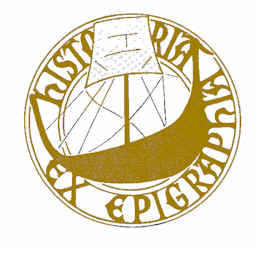
The Epigraphic Society

|
The Epigraphic Society
|
|
|
COMMENTS ON AN INSCRIPTION FROM A CATHEDRAL IN ROSKILDE, SJAELLAND, DENMARK Donal Buchanan (from his Runic Database, a work in progress)
Inscription: Transliteration: godefridus : nafuam Cognate Lang.: Godefrid : um nöf Translation: Godfrey—over the nave Comment: The graphic for this inscription is from p. 431 of Erik Moltke’s Runes and Their Origin, Denmark and Elsewhere, Denmark, 1981. His discussion of it is found on pp. 431-432. When choir benches on the north side of Roskilde Cathedral were removed in 1980, runes were discovered on the wall behind, incised into the dry plaster. Roskilde Cathedral was begun in 1160 (part of an intensive era of church-building which occurred in the 12th century and the first half of the 13th century in Denmark. It was built over an earlier church which dated from 1026. The cathedral is the burial place of many Danish kings. Vocabulary:
It is possible that runic cryptography (tied to the Church’s Easter Table—see the works of Alf Mongé) as practiced by runemasters of the time is present here. The use of stung runes indicates a date after 1050. There are 16 runes in 2 groups, 10 and 6. It happens that, using the Scandinavian Church’s Easter Table, Rati (row) 2, Y(ear)G(olden)N(umber) 10, Y(ear)D(ominical) N(umber) 6 = 1168. This is the only combination that works. 1 Dec was Advent Sunday in 1168 (23 days to the end of the ON year). I can find no pin for that date beyond the fact that the two groups of runes apparently incorporate three words, thus 2-3 or 23. A possible date for the writing of the inscription is 6 October, which has a DGN of 10 (godefridus) and a DDL of 6 (nafuam). 6 Oct 1168 was a sunday, the feast of St. Magnus. "Nafuam" = an anagram of uam naf (um nöf) = "over the nave." Godfrey (we have not identified him further; a bored chorister perhaps?), sitting "over the nave" cut the inscription in the plaster of the wall on the feast of St. Magnus, Sunday, 6 Oct 1168.
|
Send mail to donalbb@epigraphy.org
with
questions or comments about this web site.
|